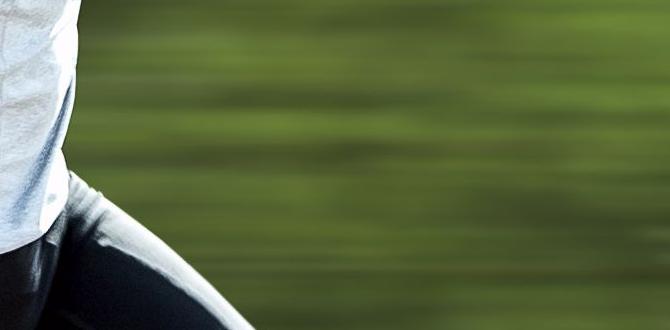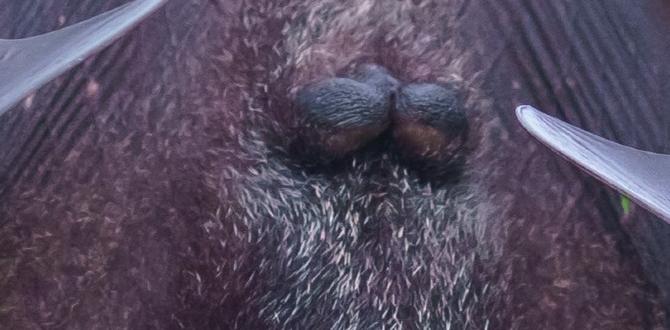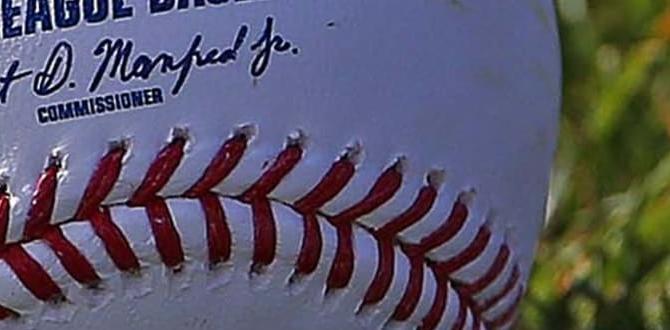Getting the perfect fit for your Louisville Slugger catcher’s leg guards is crucial for comfort, safety, and performance behind the plate. Properly fitted guards protect you from foul balls and impacts, allowing you to focus on the game. This guide will walk you through measuring, adjusting, and ensuring your leg guards are ready for action.
Ever feel like your catcher’s gear is just… a bit off? You’re not alone! Getting that perfect snug fit on your Louisville Slugger leg guards can make all the difference between feeling secure and feeling distracted. When leg guards are too loose, they can shift around, leaving you vulnerable. Too tight, and they can be uncomfortable, restricting movement. We’ve all been there, fiddling with straps in the dugout! But don’t worry, finding that sweet spot is simpler than you think. This guide is designed to make fitting your Louisville Slugger leg guards a breeze, ensuring you’re protected and ready to make every play.
Why Proper Fitting Matters for Louisville Slugger Catchers Leg Guards
Think of your catcher’s leg guards as your armor. Just like any good armor, it needs to fit correctly to offer the best protection and allow freedom of movement. For catchers, this means being able to block pitches, field bunts, and move quickly around the plate without your guards getting in the way or leaving gaps for injury. Louisville Slugger is known for its quality gear, and their leg guards are no exception. When fitted properly, they provide:
- Enhanced Protection: Guards that sit correctly prevent foul tips from hitting unprotected areas or sliding around during impact.
- Improved Mobility: Proper fit means the guards move with you, not against you. This is essential for quick reactions and agile play.
- Comfort: No one plays their best when they’re uncomfortable. Well-fitting guards reduce chafing and pressure points, letting you focus on the game.
- Durability: When gear is worn correctly, it tends to last longer. Improper fitting can put undue stress on straps and padding.
Understanding Louisville Slugger Catcher’s Leg Guard Anatomy

Before we dive into fitting, let’s get familiar with the parts of your Louisville Slugger leg guards. Most modern designs, including those from Louisville Slugger, share common components:
- Knee Cap: The main protective piece for your kneecap, often angled to deflect balls.
- Shin Guard: The long, lower portion that covers your shin.
- Thigh Guard: Some models have an attached or removable thigh protector for extra coverage.
- Straps: Usually adjustable Velcro or buckle straps that secure the guards to your legs.
- Padding: Inner cushioning to absorb impact and provide comfort.
- Lining: The material inside the guard, sometimes vented for breathability.
How to Measure for Your Louisville Slugger Catchers Leg Guards
The most critical step in fitting is taking accurate measurements. This ensures you select the right size from the start, or adjust your current gear for the best fit. Louisville Slugger typically sizes their leg guards based on leg length. Here’s how to measure:
What You’ll Need:
- A flexible measuring tape (like one used for sewing)
- Someone to help you (optional, but recommended for accuracy)
- A notepad and pen to record measurements
Measuring Your Leg Length:
You’ll be measuring from the top of your foot to the middle of your thigh. Wear the type of baseball pants you typically play in, as this can affect the measurement.
- Start at Your Foot: Stand with your heel on the ground and measure from the top of your shoe (where the laces would be) straight up to the point where you want the top of the thigh guard to sit. For most catchers, this is about 1-2 inches above the kneecap, near the middle of the thigh.
- Measure to the Kneecap: Next, find the center of your kneecap. Your measurement to the top of the guard should generally end a few inches above this point.
- Consistency is Key: Try to keep the tape measure straight and taut, but not digging into your skin. If you have someone helping, they can ensure the tape stays in place.
- Record the Measurement: Write down the measurement in inches.
Pro Tip: Many manufacturers, including Louisville Slugger, provide sizing charts on their websites or product packaging. Always cross-reference your measurements with their specific chart to find the best size. For example, a typical chart might look like this:
| Size | Length (Inches) | Approximate Height |
|---|---|---|
| Youth/Junior | 10-12″ | Under 4’10” |
| Intermediate | 13-15″ | 4’10” – 5’6″ |
| Adult Small | 15-16″ | 5’6″ – 5’10” |
| Adult Medium | 16-17″ | 5’10” – 6’2″ |
| Adult Large | 17″ + | Over 6’2″ |
It’s important to note that these are general guidelines. Always check the specific sizing recommendations for the Louisville Slugger model you are interested in. You can often find detailed specifications on retailer websites or by visiting the official Louisville Slugger website.
Step-by-Step Guide to Fitting Your Louisville Slugger Leg Guards
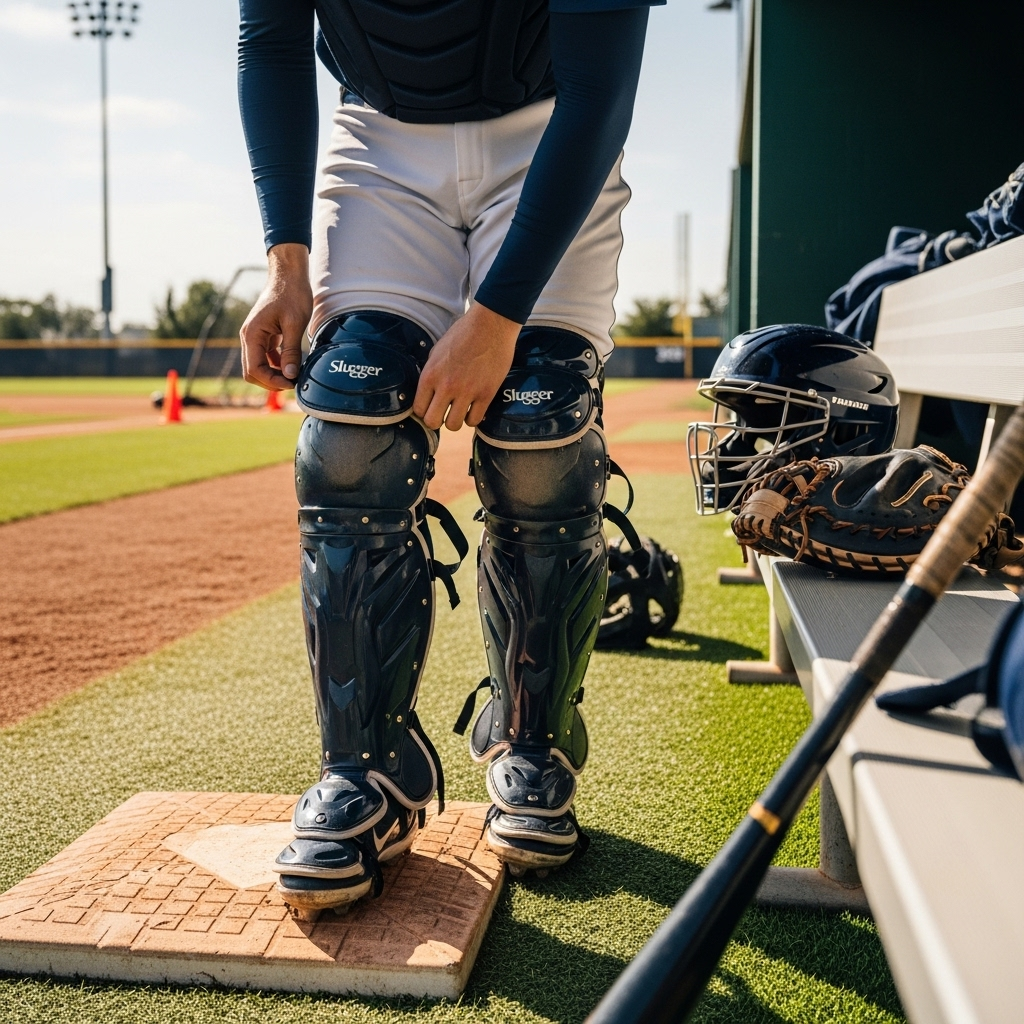
Once you have your leg guards (either a new pair or your existing ones), it’s time to get them on and adjusted. Follow these steps for a secure and comfortable fit.
Step 1: Put on Your Leg Guards
Start by placing the guards on your legs. Identify the left and right guard – they are usually shaped to fit each leg specifically. Slide your leg into the guard, ensuring your knee is centered within the kneecap padding.
Step 2: Place the Knee Cup
The knee cup is arguably the most crucial part. It should rest directly over your kneecap, providing protection exactly where you need it. It shouldn’t feel like it’s digging in, nor should it be so high that it exposes the top of your knee.
Step 3: Adjust the Straps
This is where the real fitting happens. Most Louisville Slugger leg guards have multiple straps. Start from the top or bottom and work your way around, adjusting each strap:
- Top Straps (Thigh): These straps, often near the top of the thigh guard, should be snug enough to hold the guard up without restricting blood flow. They prevent the guard from sliding down.
- Middle Straps (Shin): These straps, typically around the shin area, ensure the guard stays in place and protects your shin effectively. They should be firm, preventing excessive movement.
- Bottom Straps (Ankle/Calf): These secure the lower part of the leg guard, often around the calf. They help keep the shin guard from rotating or shifting during play.
Important: Fasten the straps one by one, checking the fit as you go. You want a secure fit that doesn’t allow the guards to move substantially when you bend your knees, squat, or stand up. However, avoid over-tightening, which can cause discomfort and impede circulation.
Step 4: Check for Mobility and Comfort
Once the straps are adjusted, stand up and squat down as if you were in your catching stance. Can you get low comfortably? Do the guards feel like they’re digging into your legs or groin area? Is there any excessive rubbing or pinching?
- Squat Test: Get into a deep squat. The guards should stay in place and not feel overly restrictive.
- Knee Bend Test: Bend your knees and extend them. You should be able to move freely.
- Walking Test: Walk around a bit. Do the guards feel stable?
If something feels off, loosen or tighten specific straps. Sometimes, even a slight adjustment to one strap can make a big difference.
Step 5: Wear with Your Gear
Ideally, you should try on your leg guards with the rest of your catcher’s gear, especially your pants. Baseball pants can affect how the guards sit and feel. If your pants are too tight, they might push the guards in an uncomfortable way. If they are too loose, they might not hold the guards in place as well.
Advanced Fitting Tips & Common Pitfalls
Even with a step-by-step guide, fitting can sometimes be tricky. Here are some tips to refine your fit and avoid common mistakes:
Tips for a Better Fit:
- Consider a Catcher’s Mitt: While not directly related to leg guards, having your mitt on helps you get into a more natural catching posture when testing mobility.
- Ventilation Matters: Look for guards with good ventilation, especially if you play in warm climates. Proper fit also allows air to circulate better.
- Adjust Over Time: Your body might subtly change, and so might your gear. Re-check your fit periodically, especially after game or practice use.
- Inner Padding Alignment: Ensure the inner padding is smooth and not bunched up, as this can lead to discomfort.
Common Pitfalls to Avoid:
- Over-tightening Straps: Leads to discomfort, numbness, and potential circulation issues.
- Loose Straps: Causes guards to shift, increasing the risk of injury and reducing protection effectiveness.
- Knee Cap Misalignment: The knee cap should cover your patella fully. A guard that’s too low or too high leaves your knee exposed.
- Ignoring Thigh Guard Placement: If your guards have separate thigh protectors, ensure they are positioned correctly and don’t interfere with your swing or stance.
- Wearing with the Wrong Pants: The fit of your baseball pants can significantly impact how your leg guards feel and perform.
Maintaining Your Louisville Slugger Catchers Leg Guards
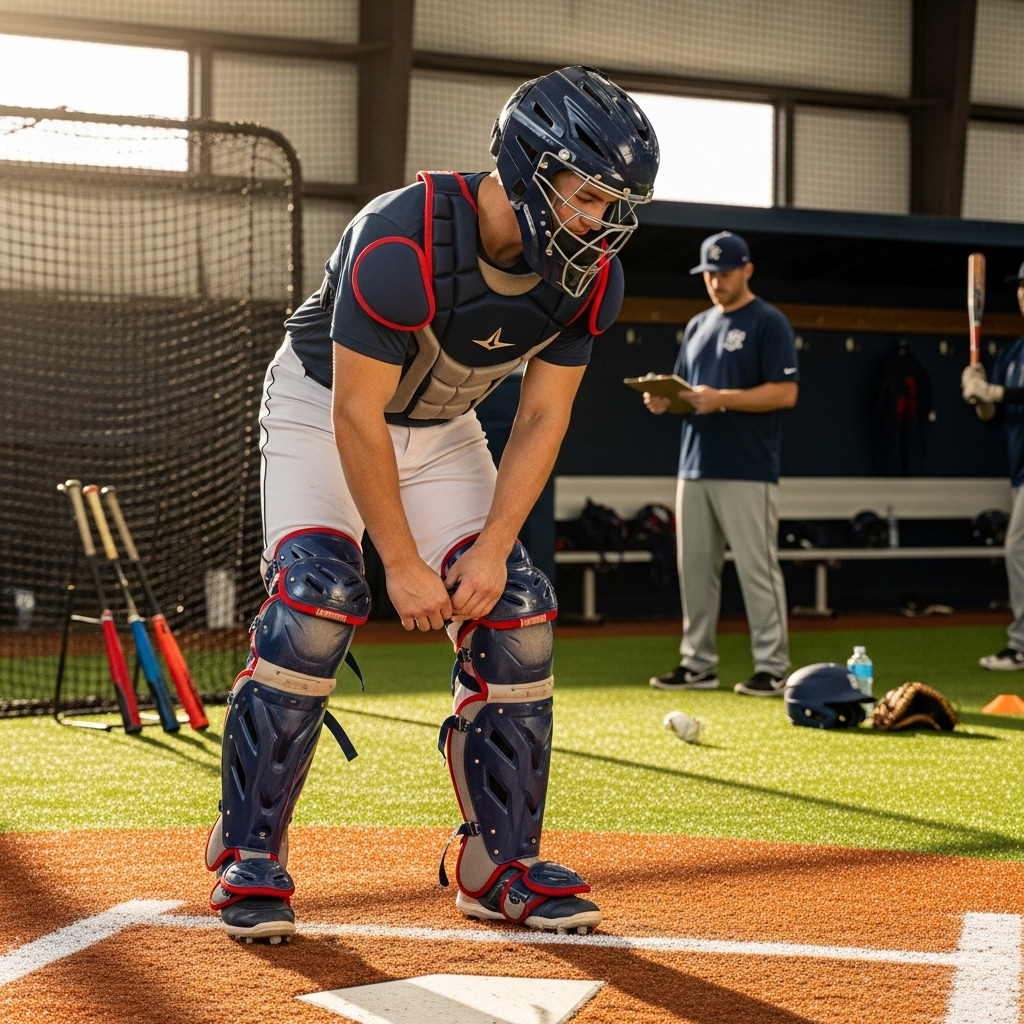
Proper fitting is just one part of ensuring your gear performs its best. Good maintenance will extend the life of your Louisville Slugger leg guards and keep them performing reliably.
Cleaning:
- Wipe down the exterior with a damp cloth after games or practices to remove dirt and sweat.
- For deeper cleaning, use mild soap and water, then rinse thoroughly.
- Allow guards to air dry completely. Do NOT put them in a washing machine or dryer, as this can damage the materials and padding.
Storage:
- Store your leg guards in a cool, dry place away from direct sunlight.
- Avoid crushing them under heavy equipment, which can warp their shape.
- Consider airing them out after each use to prevent moisture buildup and odors.
Inspecting for Damage:
- Regularly check straps for wear and tear. Replace any frayed or broken straps.
- Inspect padding for tears or compressed areas.
- Look for cracks or damage to the plastic shell.
A well-maintained and properly fitted set of leg guards is your best friend behind the plate. For more on equipment care, resources like the USA Baseball website often offer tips on equipment safety and maintenance.
FAQs: Your Louisville Slugger Leg Guard Fitting Questions Answered
Q1: How do I know if my Louisville Slugger leg guards are too big or too small?
If your guards are too big, they will slide down your leg no matter how tight you make the straps, and there might be gaps in coverage. If they are too small, they will feel constrictive, the straps might be fully extended and still too tight, and they may not cover your entire shin or knee area. Always refer to the manufacturer’s sizing chart for your specific model.
Q2: Can I wear old baseball pants with my new leg guards?
Ideally, you should wear the baseball pants you plan to play games in. Different cuts and fits of pants can influence how leg guards sit and feel. If your pants are too baggy, they might bunch up, while very tight pants could restrict your movement or cause discomfort.
Q3: My knee cap feels exposed. What should I do?
Ensure the knee cap piece of the guard is directly over your kneecap. If it’s still exposed, the guards might be too large, or the straps need to be adjusted to pull the guard higher and into place. Double-check that you’re wearing the correct size based on your leg measurements.
Q4: How tight should the straps be?
The straps should be snug enough to keep the leg guards firmly in place without shifting during activity. They should not cause numbness, tingling, or significant discomfort. You should be able to comfortably squat and move. Think secure but not constricting. If you can easily slide a finger under the strap, it’s usually a good sign it’s not too tight.
Q5: Do I need to have thigh guards on my leg guards?
Many modern catcher’s leg guards come with attached or removable thigh guards. While not strictly mandatory for all players, they offer enhanced protection against foul balls and grounders. If your Louisville Slugger leg guards have them, fitting them correctly involves ensuring they provide coverage without hindering your ability to squat or move.
Q6: My leg guards feel uncomfortable after a few innings. What’s wrong?
Discomfort can stem from a few things: straps being too tight, padding bunching up inside, or simply needing a break-in period. Try slightly loosening the straps, repositioning the inner padding, and ensure you’re wearing them with appropriate socks. If the discomfort persists, it might indicate the guards are not the right fit for your leg shape.
Conclusion: On the Field Comfort and Confidence

Mastering the fit of your Louisville Slugger catcher’s leg guards is fundamental to your game. A perfectly fitted guard isn’t just about safety; it’s about confidence. When you know your gear is secure and protecting you, you can step behind the plate with zero distractions, ready to focus on every pitch, every runner, and every chance to make a play. We’ve covered how to measure accurately, adjust those crucial straps, and test for that optimal feel. Remember to check your fit regularly, maintain your gear, and always prioritize comfort and protection. With the right fit, your Louisville Slugger leg guards will become a reliable extension of your defensive prowess, helping you perform at your highest level game after game. Now go out there and catch with confidence!


